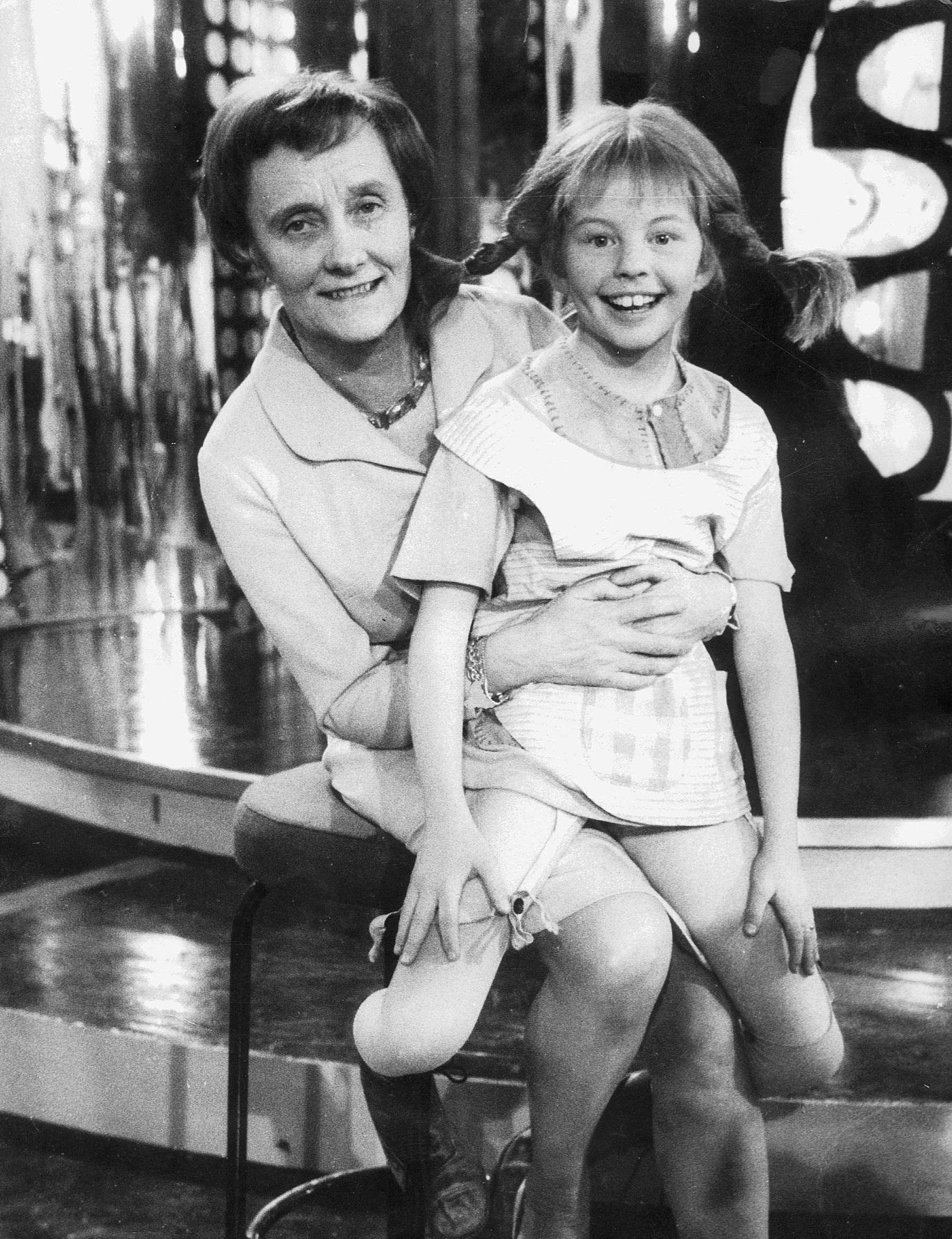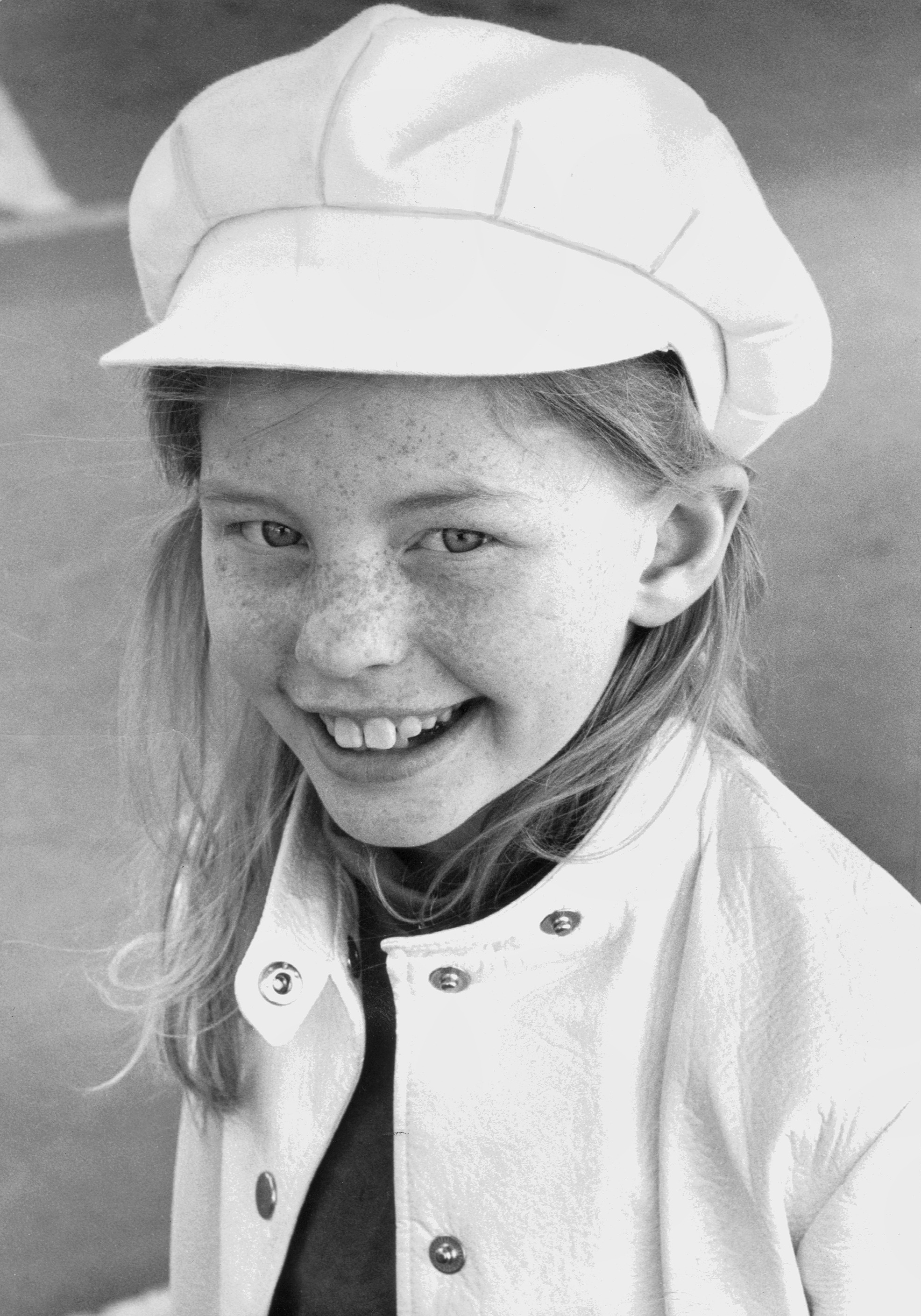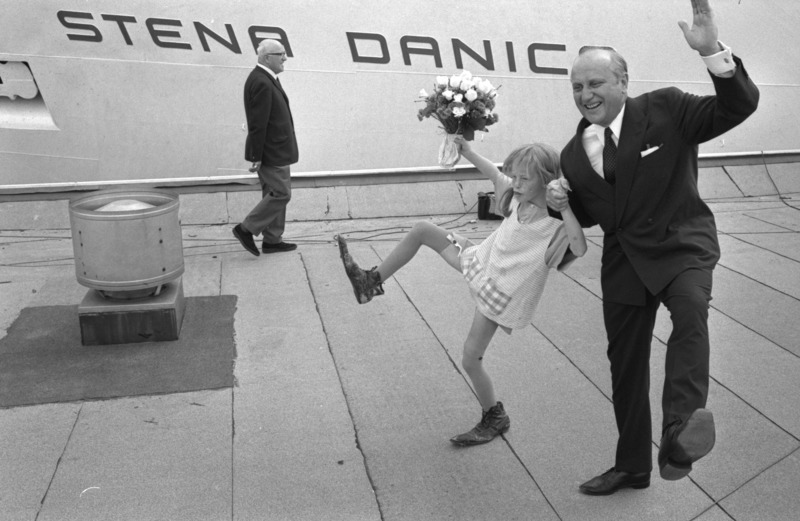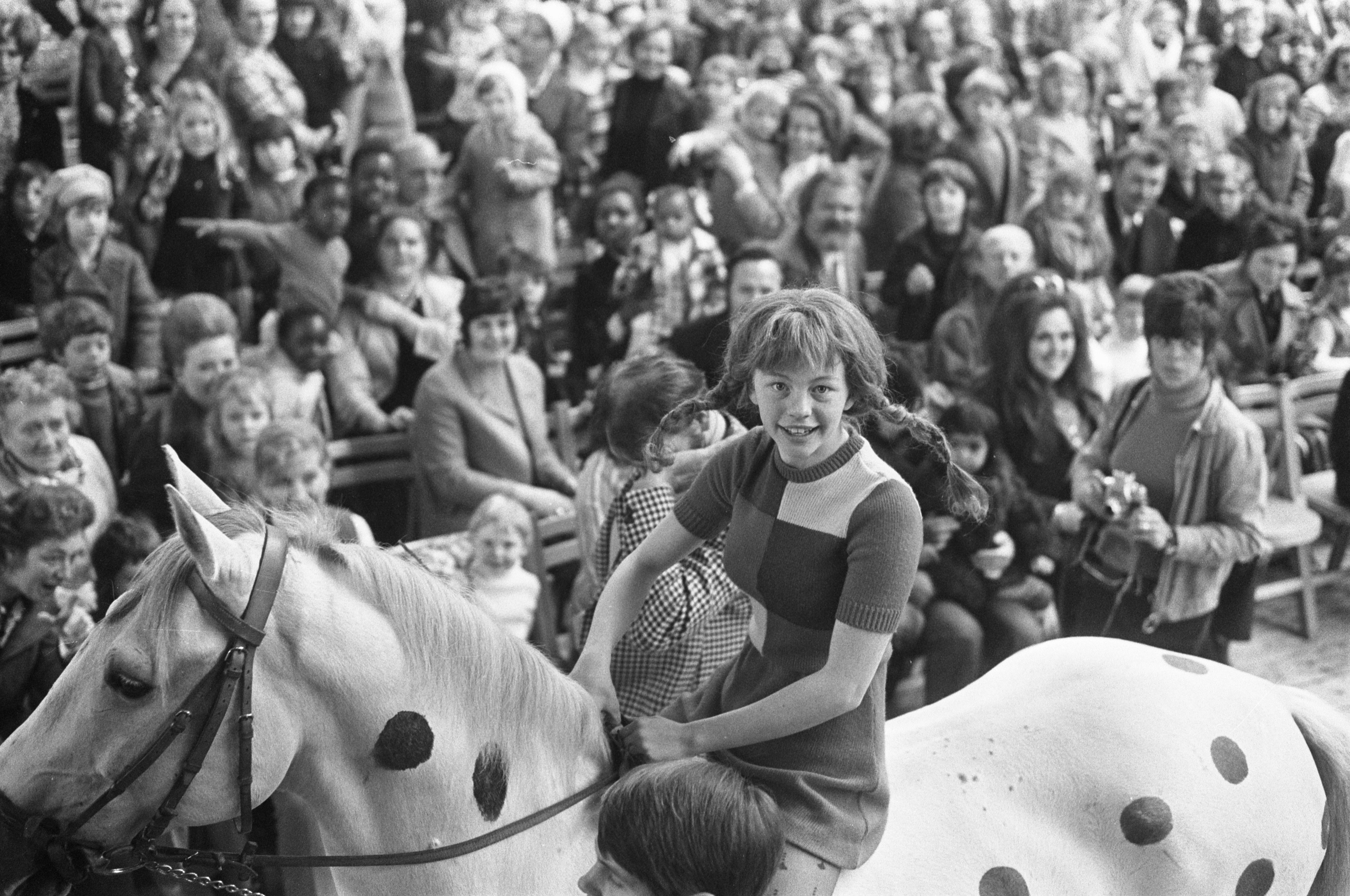
.
The world-famous Swedish writer of several children’s book series Astrid Lindgren with Inger Nilsson as Pippi Longstocking.
© Kurt Bethke / hr Historisches Arch/Süddeutsche Zeitung Photo (Germany).
Pippi Longstocking
What makes Pippi Longstocking
a classic of identity empowerment?
Written by Dr. phil. Julia Sophie Haager
Assistant Professor in the Department of Psychology at the University of Regensburg.
Regensburg, Germany – April 25, 2022
This article is part of a series published in `Televizion´, which is a magazine of the International Central Institute for Youth and Educational Television (IZI) of the Bavarian Broadcasting Corporation in Germany. This article shows, by means of a qualitative IZI study, why Pippi Longstocking is so successful and what the cheery redhead offers for identity.
“Do you want to know, do you want to know who I am?” hums the charismatic girl, standing on a table in a pirates’ inn, her hands on her hips, with a mischievous grin. Then she thrusts out her arms and legs, shouting at the pirate captain Blood Svente, “It’s Pippi Longstocking, Pippilotta Viktualia, I am Pippi Longstocking, Heigh ho ho wa hee ha ha!” The faces of the alpha males fill with horror, for no one doubts what this girl can do (Pippi in the South Seas, Swedish movie released in the USA in 1975).
A 9-year-old girl with red hair and freckles, strong, fearless and funny. She has no parents, but she lives with her monkey and her horse in her own house. She does not go to school; she sleeps the wrong way round in bed; she rolls out biscuit dough on the floor, walks backwards, and decides her bedtime herself. She starts her day with uninterrupted euphoria; she faces every danger bravely and compensates for little mistakes with wit and charm: Pippi Longstocking is the character who made Astrid Lindgren famous and unforgettable; she is an indisputable classic of children’s television.
HOW PIPPI CAME ABOUT
The story was conceived in the early 1940s at the bedside of Lindgren’s 7-year-old daughter, Karin, who was ill. She wanted to hear a story “about Pippi Longstocking”. Such an idiosyncratic name deserved a similarly idiosyncratic story, which Astrid Lindgren duly invented. Out of the creative dialogue between mother and daughter there emerged a character with a story which not only alleviated the dismal hours of pneumonia but also ultimately revolutionised children’s literature (Schönfeldt, 2014). Early on, Astrid Lindgren wrote reviews and local news for a newspaper, and never intended to send the story of Pippi Longstocking to a publisher (Schönfeldt, 2014). Luckily, she submitted it, and in 1945, the Swedish Pippi Långstrump was published by Rabén & Sjögren. Books, radio plays, films, a cartoon series and many licensed products followed. Today, the stories of Pippi are world famous. Her books have been translated into 70 languages, and around 60 million copies have been sold (Saltkråkan AB, 2015). In 2002 she made it onto the list of the best 100 books in world literature (Bokklubben, 2002).
However, the character did not always reap this kind of enthusiasm. Lindgren’s imagination did not really sit well with social conventions at the time; a young girl who lives alone and who goes against every rule by doing what she wants, even mocking the guardians of the law in the process, broke every convention. Astrid Lindgren advocated a “liberal upbringing”, which is widespread today, but when Pippi Longstocking was published in 1945, this way of thinking had not yet taken root in society (Schönfeldt, 2014). People were afraid that children could be influenced by Pippi’s manners and her defiance of authority. Astrid Lindgren responded to these assertions in a contribution to the debate on the rights of children, saying, “Give children love, more love, and still more love, then manners will follow naturally” (Saltkråkan AB, 2015).
In itself, her role as a pioneer makes Pippi a sensational story. This raises the question of whether Pippi’s “boundlessness” is central for children. If we look closer, in fact, we also find fascinating stories – flying cars and beds, pirates, policemen and burglars – and an endearing friendship with Tommy and Annika. What makes the format so strong that it has been a reference point for children’s identity issues for 70 years?
THE STUDY
In the qualitative IZI study Classics of Children’s Television from the Children’s Perspective we explored this question in more detail. 429 children in Germany were asked to choose from among the classics Pumuckl, Maya the Bee, Vicky the Viking and Pippi a character who was particularly significant for them. One third of the children (n = 135, of these, 88 girls) aged 8-11 (on average 9.22 years old) chose Pippi Longstocking. They drew and described what made the character significant for them in response to open questions. The children were asked to retrospectively explore their experiences with the character, the significant moments and their practical value. In addition, they were asked to evaluate – in the sense of the third-person effect – the effect of the character on younger children, as well as the way their parents dealt with the character. This phenomenological approach was intended to illuminate the essential core (core identity) of classic TV characters, taking into account the child’s perspective. The analyses show that from the children’s perspective there are two key areas concerning Pippi Longstocking: on the one hand, her unique character, and on the other, the fascination with her stories.

.
The Swedish actress Inger Nilsson, known for her role as Pippi Longstocking, during a visit to Munich in 1969. Date: 01/01/1969.
© Alfred Haase / Süddeutsche Zeitung Photo (Germany).
PIPPI’S UNIQUE CHARACTER AND CHILDREN’S IDENTITY ISSUES
When asked what the children found particularly great about Pippi, they identified 4 aspects what made her unique. The most obvious one is Pippi’s appearance. The children liked her “funny clothes” (Haci, 10), the fact “that Pippi Longstocking was so colourful” (Gordon, 9), “that she has two different socks on” (Lara, 10), and of course also “her red hair and pigtails” (Florian, 9). This optical peculiarity is echoed in almost every child’s drawing: orange-red hair, plaited into two pigtails. Just as memorable is Pippi’s autonomy, which is the result of her particular situation: “She lives alone in a villa, and her father is rich and is a pirate” (Samuel, 10). The freedom that comes with this certainly does not escape the children. “She did everything she wanted” (Matthias, 10) and “She solves her problems herself, without any help” (Samira, 9). In addition, “She […] lived with Mr Nilsson, her monkey, and her horse” (Fahim, 10). For children, having a pet means taking on responsibility and thereby coming a step closer to being grown up. It is unusual for children to have the kind of freedom that comes through material means and a lack of supervision, which is why Pippi Longstocking’s autonomy is as much a part of her uniqueness as her appearance. The third, and probably most prominent feature children identify is Pippi’s physical superiority. 9-year-old Sven says, “She is very strong”, and 75 other children agree with him verbatim. The fascination with this is evident in the drawings: Pippi can lift her horse, policemen, the world’s strongest man, giant snowballs, and much more (Ill. 1). Pippi also has the courage to use her strength: “Pippi Longstocking is very strong. She dares […] to do dangerous things” (Sabiha, 9). However, there is more behind this power fantasy of being stronger than others: the fact that “she can do a lot of things we cannot do, such as jump out of the window or pick up a door” (Linus, 10). The TV character here acts as a medium through which children can experience things that are physiologically not possible for them. Besides the physical deficits, this is also true for skills and ideas we learn only later in life, such as baking biscuits by yourself, cleaning, and going on adventures of your choice (Ill. 2). Interestingly, children emphasise the skills they see as important, so they do not think it is bad that Pippi “cannot count or do sums” (Araceli, 10). Quite the opposite: children think that she has “great ideas” (Till, 9) and that “Pippi Longstocking [was] […] also clever” (Emma, 10). In the eyes of a child, physical inferiority to adults and dangers is clearly more threatening than a lack of reading and maths skills. If physical superiority is combined with strong mental ability and material autonomy, the result is a character who is actually an adult. Nonetheless, Pippi is the embodiment of a child. Not only in her appearance, but also in her ideas and, above all, her humour. 59 out of 135 children describe Pippi with the words “funny” or “witty”. This fourth factor clearly distinguishes Pippi from adults. Children love the fact that “she always has really crazy ideas and is always witty” (Illana, 9). They clearly understand that “she was an extraordinary child and did crazy things” (Lea, 9), but she was certainly not an adult. From the children’s perspective, Pippi embodies not a fantasy of power but a latent fantasy of being grown up. If it is done well, this experience is something very strong in child protagonists. The desire to be bigger and older than we are is part of our psychological development. Children learn from bigger people; they are their models; they imitate them through real experiences and vicarious observations. The possibility of learning via a model has already been addressed by Bandura in his social cognitive learning theory (1975, 1977). Based on this, the concerns of Pippi Longstocking’s critics would probably be justified, for children like Pippi, and they could also learn from her. Astonishingly, our study shows that children make a clear distinction between themselves and the world and stories of Pippi. In response to the question of whether the same things happen to Pippi during the day as happen to the children in the study, only 8.9 % agree. In contrast, 76.1 % of the children say they are not like Pippi, or are only partly like Pippi, and only 11.4 % admit they do a lot of things Pippi does. The red-haired girl is therefore not an adequate role model. The children admire her like a girl heroine; they would like to have her as a friend, but they do not identify with her. The reason for this may lie in the brief moments between boundlessness, e.g. when Pippi is sad because her mother and father are not there (Pippi’s Christmas). Moreover, the children learn through Pippi’s friends, Annika and Tommy, and through their reactions, why Pippi’s behaviour is inappropriate. Children need attachment and love, which is why they say: “There were a few things I didn’t like about it, e.g. she lives alone without her parents” (Süleyman, 8). This may, however, be the reason why Pippi functions as she does, for sometimes characters need something to be “broken” in order to become children’s heroes (Wellershoff, 2007). She is therefore already, in purely factual terms, a bit different to everyone else. Children know this, too. “I think Pippi stands out because she is a normal person, but she is somehow also peculiar and different to all the other TV characters” (Ivonne, 9).

.
Stena Line / June 30, 1969 /
Svenska: MS Stena Danica II invigs av Stena Lines ägare Sten A. Olsson och Inger Nilsson i rollen som Pippi Långstrump.
Stena Line, CC BY 3.0 <https://creativecommons.org/licenses/by/3.0>, via Wikimedia Commons
FASCINATING STORIES AND ADVENTURES
If we look at the children’s answers to the question of their favourite Pippi story, we clearly see how strong the stories about the character are. Children remember everything, from brief situational experiences such as “Pippi Longstocking disguised herself as a granny and fooled her friends” (Diana, 10), to little stories such as “she went up in a hot air balloon” (Luca, 8), to content spanning several episodes. They know little details, such as “she went on a treasure hunt, but then she found a bucket and put the bucket on her head” (Niklas, 9), and they engage in the emotional experiences of the protagonist: “I thought it was great when Pippi protected a boy who was being teased” (Mira, 10). This fascination with the stories is also underscored by the pictures drawn by the children. The majority of the artwork depicts one of the stories about hot air balloons, pirates, school, snow, Christmas, policemen or burglars. That is what defines the Pippi stories: “You can always have adventures with Pippi; not so much with the others” (Giada, 10)
CONCLUSION
In the eyes of the recipients, Pippi is, and remains, above all, boundless. With this core identity she makes it possible for children, whose daily lives are restricted by rules and physical and cognitive deficits, to experience what it would be like to be boundless as a child – not as an adult. Together with Pippi, the children gain space for creative thinking and fantasies of being grown up. Pippi invites viewers to experience the world of an imaginative child who has the means of an adult. This ambivalence creates an attractive tension, which is what makes Pippi a classic of children’s television.
References:
Bandura, Albert (1975). Social Learning & Personality Development. New York: Holt, Rinehart & Winston.
Bandura, Albert (1977). Social Learning Theory. Englewood Cliffs: Prentice Hall.
Bokklubben (2002). The Library of World Literature. Available at: http://www.bokklubben.no/SamboWeb/ side.do?dokId=65500& [21.10.2015].
Lindgren, Astrid (1945). Pippi Långstrump. Stockholm: Rabén & Sjögren.
Saltkråkan AB. Astrid Lindgren. Available at: http:// www.astridlindgren.se/de [20.10.2015].
Schönfeldt, Sybil Gräfin (2014). Astrid Lindgren. Reinbek: Rowohlt Verlag.
Wellershoff, Irene (2007). Was eine Kinderbuchfigur zur guten TV-Vorlage macht. TelevIZIon, 20(2), 20-21. R
International Central Institute for Youth and Educational Television (IZI) of the Bavarian Broadcasting Corporation in Munich, Germany
Internationales Zentralinstitut für das Jugend- und Bildungsfernsehen (IZI) des Bayerischen Rundfunks in Deutschland
Rundfunkplatz 1
80335 Munich / München
Email: izi@br.de
Website: https://www.br-online.de/jugend/izi/deutsch/ueber_uns.htm
Special Note
Dr. phil. Julia Sophie Haager´s text and photo: © 29.04.2022 Courtesy of Dr. phil. Julia Sophie Haager (Regensburg / Germany) and © 29.04.2022 Courtesy of Mrs. Birgit Kinateder from the International Central Institute for Youth and Educational Television (IZI) of the Bavarian Broadcasting Corporation (Munich / Germany).

